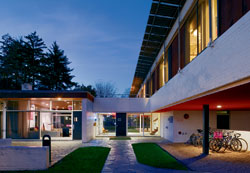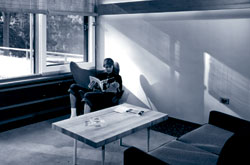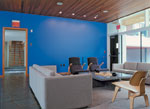Our House Is Bauhaus
In November, Ferry House alumnae/i spanning six decades convened on campus for a reunion.
Entertained by opportunities to mingle with current Ferry residents and discussions about the history and development of the house, these alumnae/i shared memories of living in one of Vassar’s most progressive—both architecturally and philosophically—housing options.
Vassar’s first modernist building and the only remaining cooperative residence on campus, the Dexter Mason Ferry House was designed and built in 1951 by Marcel Breuer, a Hungarian Bauhaus architect renowned for designing the Whitney Museum, the UNESCO Building, and the Wassily Chair. Ferry House was a shock to a gothic, traditional campus when it was built. While Vassar’s “first (and belated) venture into modern architecture,” as William H. Jordy, a Brown University professor of architecture, wrote in 1972, may not have sent shockwaves through a nation by then accustomed to the popularization of European modernism and the International Style, it most certainly caused quite a stir with students, faculty, and alumnae.
“[Ferry House] was glaringly different, but not a great controversy to most,” said Doris Kaplan Goldberg ’53, who lived in Ferry from 1951 to 1952. It was more about “excitement and wonder.” Added Nancy Beamer Dill ’53, “You couldn’t help but be interested in the architecture and design. Still, I wasn’t sure what it would be like living in what everyone was calling ‘the fishbowl.’”

The building was endowed by Dexter Mason Ferry Jr., chair of the board of the Ferry-Morse Seed Company in Detroit, and represented both a bold step for Vassar into the world of modernist architecture and a continuation of its trust in tradition and strong community relationships. (The Ferry family itself was a formidable Vassar legacy; Dexter’s two sisters, two daughters, daughter-in-law, and five nieces all went to Vassar. It was daughter Edith Ferry Hooper ’32 who suggested Breuer as the architect after his successful completion in 1949 of the first of two modernist houses for her in Baltimore.)
Support from within Vassar for architectural modernism originated from the college’s ambitious first female president, Sarah Gibson Blanding (1946–64). “We had a song about her,” said Goldberg. “Miss Blanding, Miss Blanding, Miss Blanding Makes the World Go Round.” Indeed, during her administration, Blanding made the Vassar world tilt on its axis, commissioning, in addition to Breuer’s Ferry House, Eero Saarinen’s Emma Hartman Noyes House (1958) and Paul Schweikher and Winston Elting’s Chicago Hall (1959). Blanchette Hooker Rockefeller ’31 (daughter of Blanche Ferry Hooker 1894), head of the Vassar trustee building committee and board member of the Museum of Modern Art, was an important influence on Blanding’s modernist choices.
Blanding and the board of trustees faced strong opposition, however, regarding Ferry’s proposed location in the prominent plot between Strong House and “The Circle” (as Noyes Circle was then called). Instead, Ferry was relegated to “the backyard of Vassar,” near the laundry and power generator facilities behind Main Building.
Commenting upon the unintended and yet striking stylistic contrast of the two juxtaposed buildings, Jordy noted, “The stiff effulgence of this immense reddish-violet brick block (Main Building) gives no forewarning of the taut precision and low spread of the dormitory it conceals (Ferry House).” Even stranger than the vast architectural difference between the two buildings was the fact that tiny Ferry later became the sister dormitory of populous Main Building, resulting in the nickname “David and Goliath.”
At the time Ferry was constructed, cooperative living was not a new idea on campus, but it had not been permanently incorporated into the college plan. In the wake of the Great Depression, cooperative living was created both to afford scholarship students the ability to make ends meet at Vassar and to try a new style of living. As home of the department of euthenics, Blodgett, in 1933, was designated the appropriate site for an experiment in the first full-fledged campus cooperative.

The same year Blodgett went cooperative, Raymond House became a “self-help house” so that more students could decrease tuition payments by performing dining and cleaning services. This partial cooperative proved to be a well-liked experiment rather than an impediment to the academic or social life of students. Indeed, it had such a positive social effect that it became an increasingly popular mode of living on campus. One senior at the time wrote, “There is very little evidence of the ‘clique’ spirit so often observable in a college dormitory, and no difference between the classes….The spirit of cooperation is exceptionally high, and every one is willing to help out.” A freshman added, “Besides the mechanical training it affords, it trains us in a practical way to be considerate of others. When one has to care for something used by the group, one realizes the unnecessary work created by thoughtlessness.”
In 1938, 22 students moved from Blodgett, which was being consumed by its academic uses, into the newly remodeled Palmer House on the Vassar Wing Farm, some distance from campus. Vassar Historian Elizabeth Adams Daniels ’41 lived there from 1938 to 1940. “We had a common problem, which was not enough money,” she said. “We had to work very hard. There were committees—people to cook, clean up, and devise recipes—and we were a happy group.” However, geographically isolated as they were, Palmer students felt a lack of participation in college activities. In 1947 Palmer House was closed to make room for faculty housing.

Therein Breuer clearly aligned himself with the social philosophy that he would later express regarding architecture. His purposeful design of Ferry as a crossroads of communal prosperity and aesthetic pleasure, rather than as just an architectural machine of precision, matched his Bauhaus education and philosophy, which emphasized “the social responsibility of art and design…. This led students to an engagement with building, particularly with housing, in their crusade to remake the world in the aftermath of the war,” as Isabelle Hyman wrote in her 2001 book, Marcel Breuer, Architect: The Career and the Buildings.
In Ferry House, one finds a commitment to social responsibility in its clear design for cooperative living and the cues that its inhabitants take from its organizational purpose. However, after living in the house, many residents have also cultivated an aesthetic appreciation for its design. In an architectural world of excess, it seems radical to suggest the idea that modest Ferry propagates—that beauty serves a practical purpose and that practicality is beautiful. Breuer “modified the strict machinelike modernism of the 1930s into a very particular American mode that included modern stone materials and an interest in texture and linking the building to the landscape,” noted former Vassar President and architectural historian Frances Fergusson.
The simplicity of Ferry’s binuclear design, a design originally created and instituted by Breuer in his Geller House—“in which public and private activities are formally separated by volume and spatial composition,” wrote Karen Van Lengen ’73 and Lisa Reilly ’78 in The Campus Guide: Vassar College—is executed by layering the ground and upstairs floors into a T-pattern so that sound from the downstairs common areas does not travel to the private living quarters upstairs. The intended exterior effect of the binuclear arrangement was “covered outdoor areas for ping pong tables, games, bicycles, and an uninterrupted through-view underneath,” as indicated in the 1951 dedication speech.

Few other houses in the world have been intentionally designed as cooperatives, with each architectural and design detail oriented toward making the cooperative a smooth-running, successful social venture. Breuer stated in his dedication speech that “the dormitory… should be run as automatically as possible. The plans, the details, even the furnishings and colors have been arranged around these main conclusions.”
In 1995 an initial renovation of Ferry House (funded by Patricia Parton Rosenwald ’56 and husband John) was undertaken, based on original drawings by Breuer. However, the building still needed central structural renovations, and an opportunity arose when Avery underwent renovation for its transformation into the Vogelstein Center for Drama and Film, making Ferry House nearly uninhabitable due to the construction noise.
The renovation began in 2000. President Fergusson recruited Herbert Beckhard, who had worked with Breuer & Associates and was not only familiar with the architect’s style, but would also have an idea of how Breuer would creatively solve a modern problem while maintaining veracity to its original form. And problems there were—the pipes and sprinklers, the windows and the landscaping, the fire codes; the architect had 50 years of usage to renovate creatively.
Beckhard’s associate Yutaka Takiura said, “The question was how to keep the original spirit alive but accommodate today’s students’ lives. We modified it based on what we thought Breuer would do now.” Though Beckhard passed away in 2003, before the project was completed, Takiura continued the project in the same spirit. And Takiura had the opportunity to chat with Breuer’s wife for philosophical and practical inspiration. “She said that Breuer thought modernism was about decency, not about being flashy or expensive,” said Takiura. “Breuer wanted to spread good design to everybody, not just to a limited number of people.”
Although plaster was used for the original ceilings, Takiura and Beckhard chose heart cypress for the new ceilings, to add additional warmth and counteract the cool slate below. The heart cypress also performs an additional function of recalling the memory of the Dutch elms that originally cradled the second floor of the cooperative, framing them in a natural fashion until taken by Dutch elm disease. The original cerulean Breuer blue of the downstairs lounge and the original crimson-orange Breuer red of the underside of the building were vibrantly restored. The heating and plumbing systems were revamped, and the roof was patched.
Care was also taken to replicate the original furniture design, though in a different layout. Takiura requested Californian manufacturers to reproduce the original Saarinen grasshopper chairs for Ferry, even though they had stopped manufacturing them. “They were very important in Breuer’s original design, and we needed them because they showed the spirit of the time.” The chairs were placed in both the downstairs and upstairs lounges instead of in students’ rooms. Eames chairs were used in the dining room, true to the original setup. Reproductions of the original Nelson vintage benches had already been brought in several years earlier during a partial restoration.
The influence of Ferry House upon its alumnae/i seems monumental. Such a unique microcosm of life at Vassar would not have been quite so inviting or well-designed without Breuer’s forethought. Said Lee Perkins ’64, “It is one thing to study environmental concerns, cooperative living and consensus making, and politics in class. [But] Ferry is putting the theory into practice.”
While college is often a memorable period, the memories that Ferry students have made seem more complicated due to the additional tasks and struggles they faced together in running a house while tending to their academics. Nancy Beamer Dill ’53, president of Ferry House in 1952, recalls one night when her calculus homework piled up and she had six lemon meringue pies to cook as the dessert chef. “It was the one and only time in my life I stayed up all night. But we all took turns cooking, and it made it easier.”
It has been a question of debate whether Vassar should have more cooperatives, considering the high level of applications to Ferry House and the numbers of students who are turned away each semester. “More coops should be opened because they are warmer places socially,” said Dill. “There’s a place for the dorm experience, but small is beautiful, and I was grateful to be chosen to go into a smaller house.”

Life after Ferry has most certainly been influenced by the lessons learned there in environmentalism, social networking, community, house management, art, music, architecture, event planning, and problem solving. Margaret Hellie Huyck ’61 said, “I find my perceptions of Vassar are very influenced by my life at Ferry. At my home now we have a mini-Ferry, with visitors in the guest quarters of two adjoining apartments of 11 rooms and four bathrooms. So we have managed to maintain much of the wonderful cooperative lifestyle, balancing privacy and sharing.”
“Ferry was my first exposure to that atmosphere, and, along with the left-leaning ethos on campus, confirmed in my mind that the liberal values of equality and community were appropriate for me,” said Patricia Longley ’65. “I briefly considered intentional communities twice in my life, but found myself drawn to… condominium living, which is marked by a sense of community with shared social activities and cooperative decision-making via consensus.”
Margaret Seligman Lewisohn, chair of the trustee committee on undergraduate life just before Ferry opened, concluded, “I believe firmly that a cooperative house is a necessary addition to any American campus….It can be an important and living demonstration of democracy in action.”
Kim is a freelance journalist whose work has appeared in McSweeney’s, Hyphen Magazine, and various Brooklyn and New York City-based publications. In her spare time, she works for the Bindlestiff Cirkus and OhMyRockness.com. Kim lived in Ferry for one-and-a-half years while at Vassar.
Download and read the 1951 VQ article about Ferry House.
